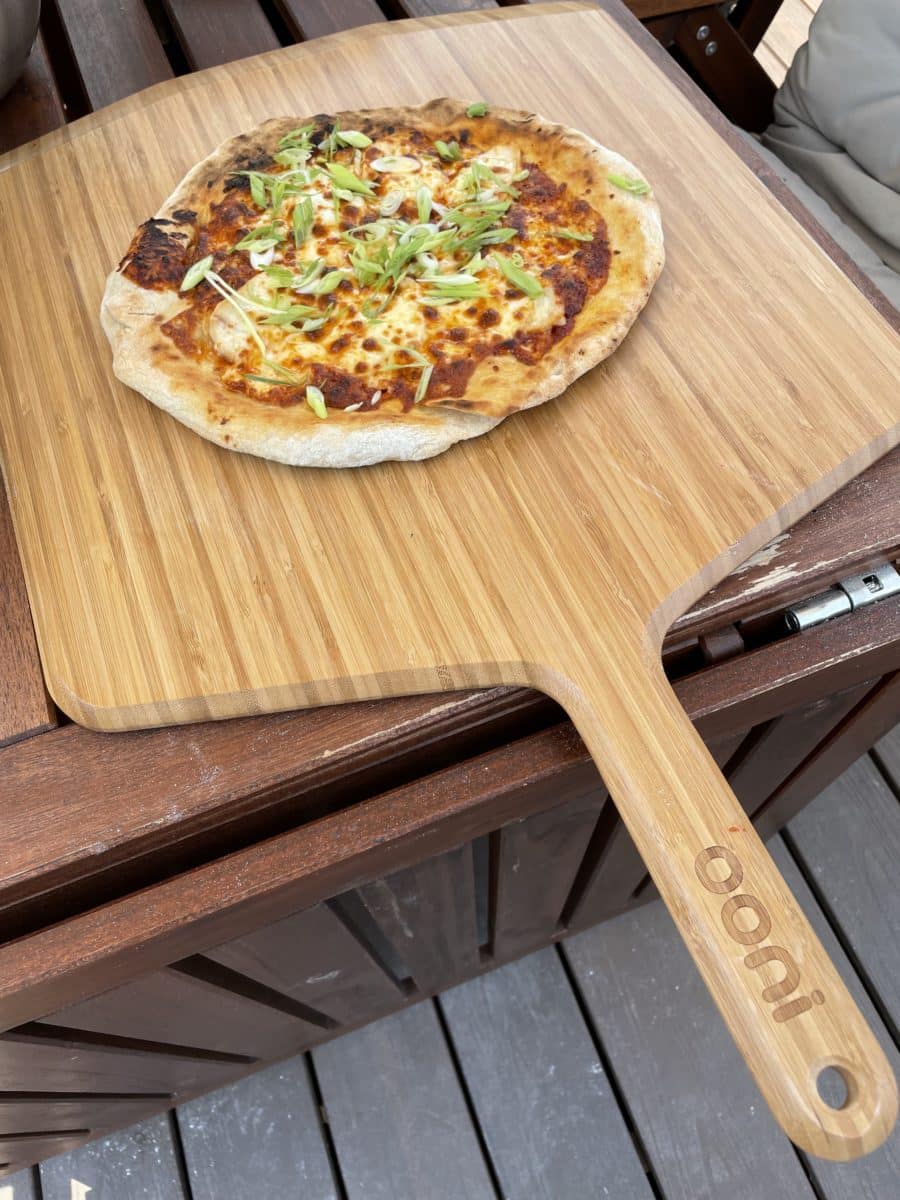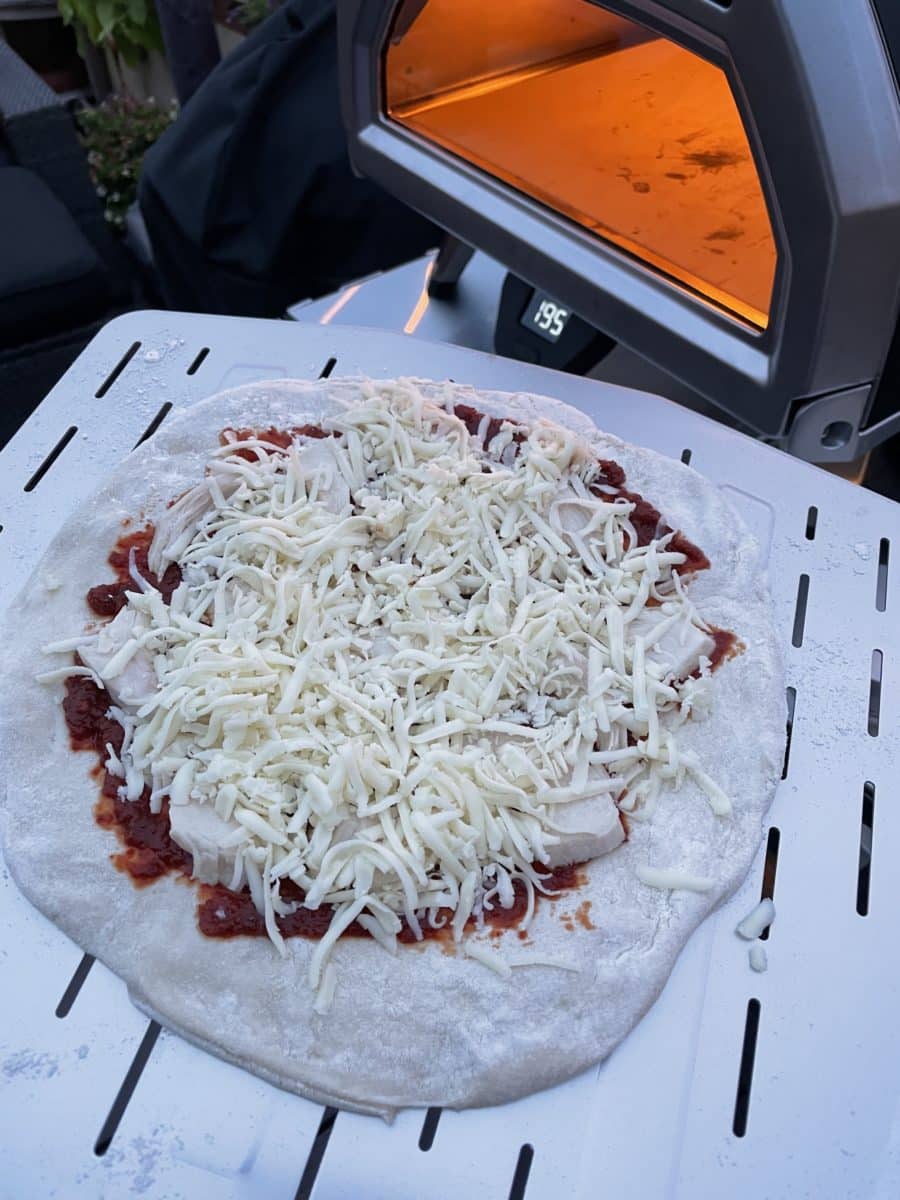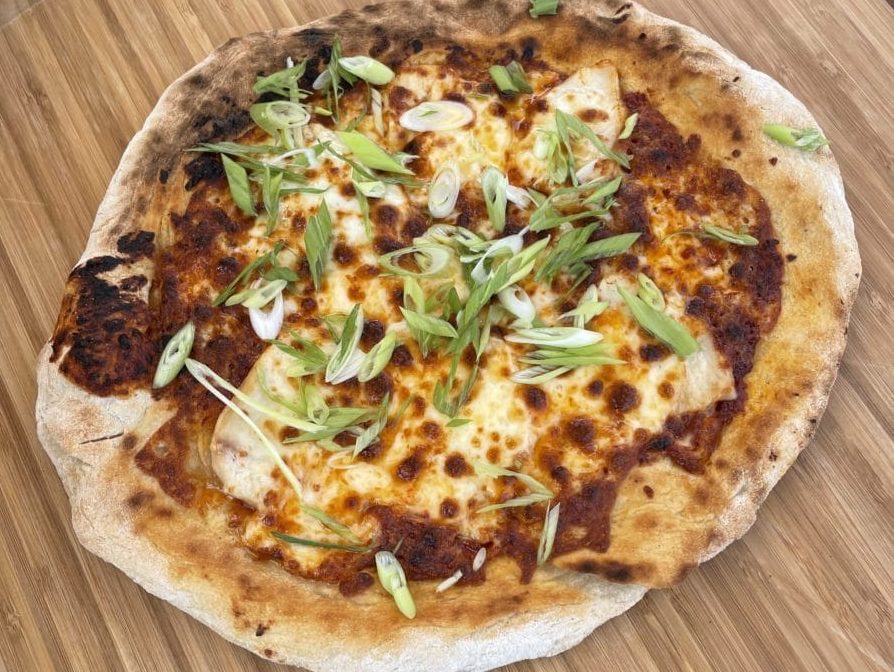
Because I’m a professional recipe developer and food writer, it takes a lot for a dish to capture the attention of my household. Something has to be really good for us to return to it over and over again.
Maangchi’s version of the Korean dish, cheese buldak (“fire chicken”), is one of those dishes. It’s an absolutely glorious recipe, chicken cooked in a sweet and spicy sauce that gets blanketed with mozzarella then browned under a broiler. Maangchi’s video for it has been viewed literally millions of times.
So when I was given the opportunity to develop a recipe using Ooni’s new Karu 16 pizza oven I knew immediately that I wanted to make a version paying homage to Maangchi’s recipe.
Let’s be clear though; while I have pizza’d this recipe, I cannot take credit for truly “inventing” anything here. South Korea has a robust pizza culture and I am sure I’m not the first person to buldak a pizza. My sauce is also inspired by Maanchi’s recipe, which I’ve tweaked for my own preferences by boosting up both the garlic and ginger, and by incorporating a fair amount of water to create a sauce with a consistency I think is perfect for pizza. I’ve also taken a cue from the New York Times version of her recipe, and have replaced the corn syrup with light brown sugar. My version isn’t a copy of her work, but it’s close enough that, really, she deserves the credit here.
I’m also recommending that you poach or sous vide your chicken and shred your own mozzarella. This recipe really needs chicken breast, which dries out faster than a shallow puddle in the sun. Cooking it gently (either via poaching or sous vide) helps it retain moisture and makes it easy to shred without it getting chalky.


Shredding your own cheese is even more vital. Bagged, pre-shredded mozzarella is coated in ingredients like corn starch to help keep it from clumping, and that extra starch helps to prevent it from fully emulsifying with the sauce. You’re much better off buying a block of whole-milk, low moisture mozzarella and shredding it yourself on a box grater. If you can’t get that pre-wrapped at your supermarket just head to the deli counter and get them to saw off a pound-sized block for you—it’s the same kind of cheese they slice for sandwiches.
This recipe also owes thanks to Ed LaDou, who legitimately invented the BBQ Chicken Pizza at California Pizza Kitchen. LaDou came to CPK from Wolfgang Puck’s famed restaurant Spago, and without him, well, we very well might not have the glory that is BBQ chicken pizza. Although this recipe has distinctly Korean flavors, and buldak sauce is not BBQ sauce, there’s no denying that there are similarities.
Ingredients
For the chicken:
- •454 grams (1 pound) boneless, skinless, chicken breasts
- •Kosher or sea salt (see NOTE)
For the buldak sauce:
- •50 grams (½ cup; 1 ¾ oz) coarsely ground gochugaru (Korean red-pepper flakes)
- •81 grams (4 tablespoons; 2 ¾ oz) gochujang (Korean red-pepper paste)
- •80 grams (6 tablespoons; 2 ¾ oz) light brown sugar
- •10 medium garlic cloves (40 grams; 1 ¼ oz), peeled and grated on a microplane grater
- •5 cm/2-inch (31g; 1oz) piece ginger, peeled and grated on a microplane grater
- •30 ml (2 tablespoons) soy sauce
- •2.5 (½ teaspoon) freshly ground white pepper
For the dough:
- •Prepared pizza dough—use your favorite recipe, such as <a href="https://ooni.com/blogs/recipes/classic-pizza-dough" target="_blank">Ooni’s Classic Pizza Dough</a>, or the prepared dough of your choice. If you have a local Neapolitan pizzeria, ask them if they can sell you some prepared dough!
For topping the pizza:
- •454 grams (16 ounces) low-moisture whole milk mozzarella, grated using the large holes on a box grater
- •Scallions, thinly sliced at a sharp bias (into “horse ears”) as a garnish
NOTE: How much salt to use depends very much on its type, grain, and provenance. This recipe was tested using 15 grams (1 tablespoon or 1/2-ounce) of Diamond Crystal brand kosher salt. The same amount of fleur de sel may be used. The equivalent in table salt is 18 grams (2/3 ounce).


Preparation
- For the chicken:
To poach chicken
Fill a medium-sized pot with 1.5 liters (6 cups) of water. Add 11.3 grams (1 scant tablespoon) kosher salt to water. Add chicken breasts and bring to a boil, uncovered. When water comes to a boil immediately remove from heat, cover, and let sit for approximately 5-15 minutes. Check temperature every 5 minutes with an instant-read thermometer and remove from water when center of chicken breast reads 65°C (150°F). Let cool and refrigerate.
To cook chicken sous vide
Set up sous vide circulator and set to 65°C (150°F). Season chicken breasts lightly with kosher salt and place in either a zipper-lock or a vacuum-seal sous vide bag. Remove air from the bag using either the displacement method or a vacuum sealer. Once sealed, place chicken into the heated water bath and cook for 1-4 hours.
10 minutes before cooking time has elapsed prepare a water bath by filling a large bowl with water and ice. Remove chicken at the completion of cooking and transfer to water bath to cool. Once cooled, remove from water and transfer to a refrigerator.
Combine the gochugaru, gochujang, light brown sugar, garlic, ginger, soy sauce and white pepper in a medium non-reactive bowl and mix well. Add 177 ml (12 tablespoons or ¾ cup) water, 1 tablespoon at a time, mixing to fully incorporate, until you’ve reached the consistency of BBQ sauce (it may take a bit more or less water).
Remove cooked chicken from refrigeration and thinly slice against the grain. Then, gently shred the chicken into thick strands and store in a bowl.
Set up Ooni Karu 16 oven and preheat to your desired temperature using your fuel of choice.
When oven is preheated, generously flour your Ooni pizza peel and, working quickly, stretch dough on it. Spread dough with desired amount of sauce. Layer generously with shredded chicken and cover with shredded cheese. Launch pizza into oven and position in the back-center. Rotate pizza using Ooni pizza turning peel to ensure even browning. Keep in mind: depending on your desired oven temperature, your pizza may cook to completion in between 1-2 minutes!
Remove pizza using Ooni pizza peel and place on a cutting board, or a wooden Ooni pizza peel. Cover pizza generously with sliced scallions and slice and serve immediately.

